Win Wan Corral Pond
Win Wan Flat West Pond
Winter 2022 Fairy Shrimp Hatching History in the Garfield and Candelaria Hills and the Gabbs Valley Range
What Can We Learn from the Ponds in the Gabbs Valley Range?
The Gabbs Valley Range extends from west of Gabbs Valley south to the Pilot Mountains east of Mina. There is a nearly continuous 10-15 km (6-9 miles) wide ridge 53 km (33 miles) long from Nugent Wash to the road from Mina around the north end of the Pilot Mountains. However, the hills of Mystery Ridge and Gabbs Mountain extend the range another 5-8 km (3-5 miles) northeastward into southern Gabbs Valley. The Gillis Range is west of the northern part of the Gabbs Valley Range but map labels do not make the location of the boundary clear. Win Wan Valley separates the ranges but the hills run together north and south of Win Wan Valley. Gabbs Valley and Stewart Valley lie to the north and east and Soda Spring Valley is west of the southern part of the Gabbs Valley Range. The hills of the Gabbs Valley Range are unlikely to have ponds but there are a few small, flat-floored valleys: Win Wan Flat, Calvada Flat, and Sunrise Flat. 7.5-minute topographic quadrangles show at least 2 stock ponds, both of which are on Win Wan Flat.
Elevations in the Gabbs Valley Range are 1,500-2,300 m (4,920-7,550′), except for Mt. Ferguson which reaches 2,546 m (8,350′).
Desert scrub covers the lower elevations but sagebrush occurs in the higher areas and there are pinyon-juniper stands or scattered trees in some areas.
The Gabbs Valley Range is almost entirely public land managed by the Stillwater Office of the BLM. The Gabbs Valley Range Wilderness Study Area covers the area around Mystery Ridge, Gabbs Mountain, and Mt. Ferguson. There are small parcels of private land at Indian Spring, Rabbit Spring, and the corral near Gillis Spring. There is a block of private land southeast of Calvada Summit, where mining claims at the reclaimed Santa Fe Mine were patented. There are also a few patented claims on the west slope of the range west of Volcano Canyon. The Isabella-Pearl gold mine, on the north side of Nevada 361 where it turns into the canyon west of Calvada Summit, is not on patented claims but should be avoided as it is currently (2021-2023) operating. Nevada 361 between Luning and Gabbs bisects the range.
Win Wan Corral Pond (Stillwater BLM Office)
___This map is a screenshot of The National Map (Go to The National Map). The U.S. Geological Survey generally does not copyright or charge for its data or reports (unless printed). A pond location is indicated by an “X”, which corresponds to the coordinates given in the data spreadsheet. Labels in quotations are from 7.5-minute topographic quadrangles.
___Red lines are the U. S. National Grid with a spacing of 1,000 m and intersection labels consisting of the UTM zone (e.g., 11S, 12T), a 2-letter 100-km square designation (e.g., LC, XN), and a 4-digit number. The first 2 digits of the number represent the 1,000-meter Easting and the second 2 digits the 1,000-meter Northing, as seen in the example Easting and Northing. Unlike latitude and longitude, the National Grid is rectilinear on a flat map, the units of abscissa and ordinate have equal lengths, and the units (meters) are measurable on the ground with a tape or by pacing.
___There is no private land on this map according to the PAD-US 2.0 – Federal Fee Managers layer of The National Map. All lands are public.
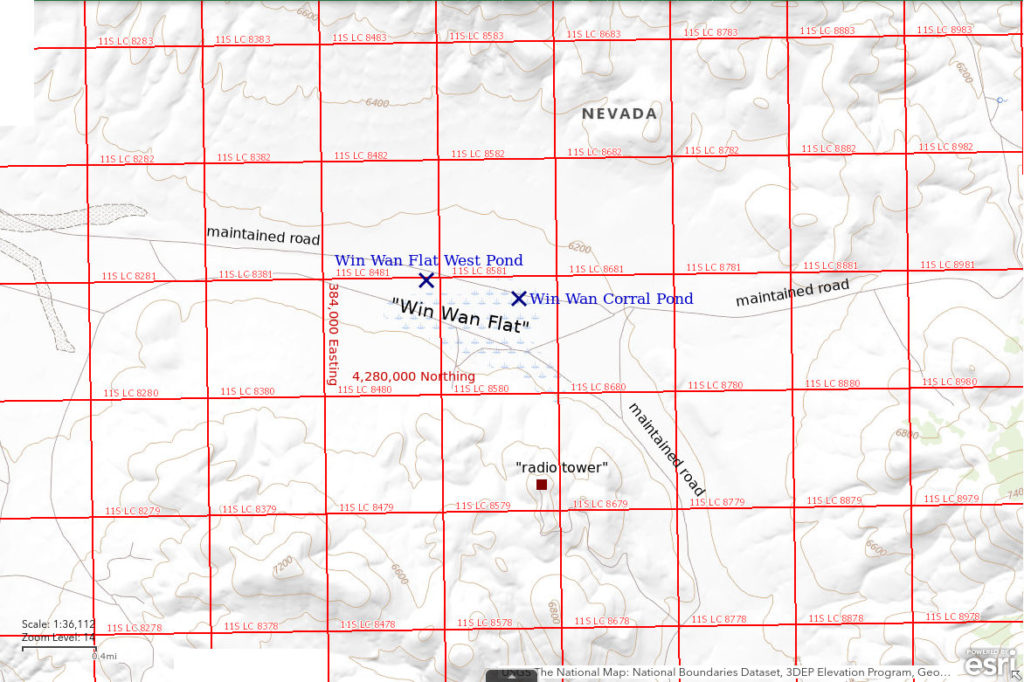
Win Wan Corral Pond is about 31 km (19 miles) northeast of Hawthorne on the playa of Win Wan Flat. The 1:100,000-scale BLM map and the Win Wan Flat 7.5-minute quadrangle lack symbols that would indicate a playa. As shown above, The National Map has a poorly chosen marsh symbol over an area of about 1,450 m (4,760′) east-west by 750 m (2,460′) south-north, which is close to the area with the smooth clay floor and lack of brush on the playa part of Win Wan Flat. The Win Wan Flat quadrangle has 2 small, dashed blue circles on Win Wan Flat. The eastern one likely represents Win Wan Corral Pond. The pond is within a corral of barbed wire and mostly wooden posts. The pond is heavily used by feral longhorn cows and horses.
Win Wan Corral Pond can be reached by occasionally maintained roads from the east, west, and south. From the east, the route turns west off Nevada 361 5 miles north of Luning, swings south around the Isabella-Pearl mine, goes over Rhyolite Pass, turns south off the main road near the corral at Rabbit Spring, and then goes over the ridge to Win Wan Flat. From the west, there is a road that turns east off the Thorne – Ryan Canyon – Rawhide Mine road out of Hawthorne about 12 miles from the Thorne railroad crossing and proceeds up Win Wan Valley to Win Wan Flat before joining the road over Rhyolite Pass. The route from the south turns north off US 95 about 7 miles west of Luning onto the Paymaster Canyon road, crosses Soda Spring Valley, turns east and then north, and ascends a canyon to Win Wan Flat. The road through Win Wan Flat passes within 50 m (160′) of the pond. Due to the abundance of clay on the playa, these roads may be difficult or impassable when wet.
Elevation: 1,882 m (6,175′)
March 14, 2019
The road to the pond from the south was very muddy and that was before I got to the heavy clay. I elected to walk the last kilometer or so. There are local patches of icy water less than 2 cm deep and a few patches of snow scattered through the brush on the playa south of the pond.
- Oval pond about 18 m x 65 m long; less than 30 cm deep.
- Opaque pale brown water; ice on surface at 1600.
- Sparse, pale gray fairy shrimp less than 10 mm long with green material in intestines.
- Didn’t see other animals.
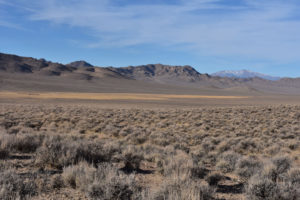
Win Wan Flat with Win Wan Corral Pond in corral at left. The area of dried, yellow vegetation is the brush-free, clay-floored playa. Mt. Grant is on the horizon at right. This photograph was taken the previous year when the pond was dry.
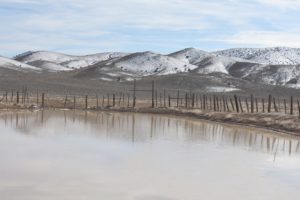
Bank-full Win Wan Corral Pond, looking south. The rough surface on the water is ice but fairy shrimp have already hatched.
April 10, 2019
The pond is much smaller and the surrounding flats are dry.
- Approximately 15 m x 30 m; probably less than 20 cm deep.
- Opaque pale brown water.
- Pale gray fairy shrimp 15-20 mm are fairly common (up to 10 per net).
- Other animals not noted.
April 19, 2019
The pond is smaller still with the shore deeply pock-marked by cow hoof prints.
- Less than 15 m x 30 m; less than 20 cm deep.
- Opaque pale brown water.
- Fairy shrimp still present and still 15-20 mm.
- Other animals not noted.
May 18, 2019
Mud is too soft and sticky to wade out more than 2 steps.
- Maybe 10 m x 16 m; at least 10 cm deep.
- Opaque pale brown water.
- Few fairy shrimp (1-2 per net) still 15-20 mm long.
- Other animals not noted.
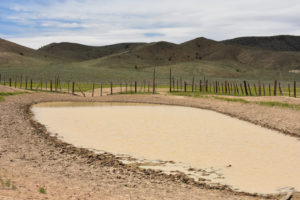
Win Wan Corral Pond, looking south similar to photograph Win Wan Corral Pond 2019-03-14, #01. The pond is much smaller now but it still has fairy shrimp.
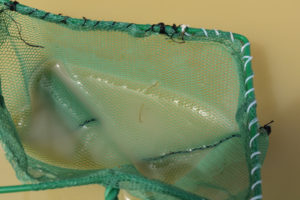
2 fairy shrimp in the net at Win Wan Corral Pond. Although my notes gave the lengths as 15-20 mm, these are at most 10 mm long compared to the mesh size of the net. Either I grossly overestimated lengths or the pond has more than 1 generation.
June 21, 2019
Deep horse hoof prints make dragging the net through the water from the shore impractical and I can’t wade out far. Comparing photographs later, it looks like the pond is about the same size or higher than a month ago so it may have been replenished by precipitation, although there was none in Reno.
- 10 m x 16 m or greater; at least 10 cm deep.
- Opaque pale brown water.
- No fairy shrimp netted.
- Sparse (about 1/net) water boatmen(?) (sub-order Heteroptera, family Corixidae); killdeer-like bird on water but killdeer usually walk along shoreline.
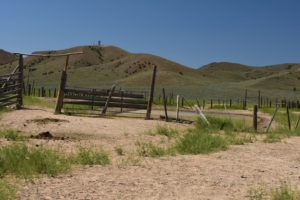
Win Wan Corral Pond, looking south. It still has water but apparently no fairy shrimp. The recent horse biscuits at left, next to an old pile of horse biscuits, indicate the pond is used by horses. This is confirmed by the deep hoof prints in the mud. The cows that were here earlier are mostly gone. Could cow and horse urine and feces in the water affect fairy shrimp longevity?
April 8, 2020
Few slicks of water on the mud flat.
- Dry.
March 17, 2022
Unlike Win Wan Flat West Pond today, there is no ice.
- 3 m x 5 m; mostly very shallow but 5 cm deep in hoof prints.
- Murky pale brown water; 7 C at 1300 on a cloudy day.
- No fairy shrimp.
An almost dry pond was a surprise after the abundance of water in Win Wan Flat West Pond. The pond is now mostly just an array of barely linked hoof prints. I don’t remember the ditch across the road at Win Wan Flat West Pond and it’s clear the ditch and its extension along the northern edge of the playa have been bladed within the past year or so. This work may have resulted in less water draining into Win Wan Corral Pond and more into Win Wan Flat West Pond. That may explain why I didn’t notice Win Wan Flat West Pond in 2019.
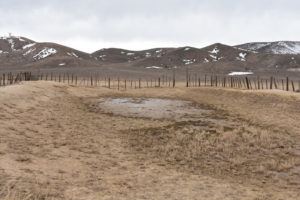
Win Wan Corral Pond, in view similar to photographs Win Wan Corral Pond 2019-03-14, #01, and Win Wan Corral Pond 2019-05-18, #02. The mostly dry banks indicate the pond wasn’t much deeper earlier in the winter. The December storms that left record snow depths at Donner Pass in the Sierra Nevada evidently didn’t produce much precipitation here. Nonetheless, Win Wan Flat West Pond filled up. While some fairy shrimp eggs there hatched, the eggs here will have to wait.
March 24, 2022
Some damp mud but no water.
- Dry.
August 24, 2023
The pond is about as big as it can get, which makes the length much greater than the width. Whatever ditch work had redirected dispersed, over land flows into Win Wan Flat West Pond and away from Win Wan Corral Pond in early 2022 has been nullified by the summer thunderstorms. Win Wan Flat West Pond is dry now and the ditch crossing the road there has mostly filled in. Tracks indicate Win Wan Corral Pond is being used by horses and cows. The thunderstorms did not bring only good news as they severely damaged the road to Win Wan Flat from the west in several places. County maintenance fixed some of those. There is also a major chasm in the road from the east.
- Less than 15 m x 60 m; greater than 25 cm deep.
- Opaque pale brown water.
- Abundant, reddish fairy shrimp 5-10 mm without eggs and sparse pale gray fairy shrimp 20-25 mm long; I don’t know if I saw any large females so I don’t know if the population of large fairy shrimp has eggs or not.
- Water boatmen (sub-order Heteroptera, family Corixidae).
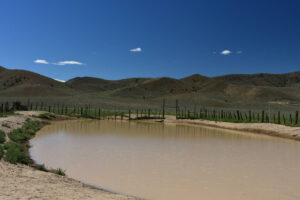
Win Wan Corral Pond with lots of water after summer thunderstorms. The water extends through the fence on the south side of the corral as in March 2019 (compare Win Wan Corral Pond 2019-03-14, #01). As shown in the video below, the water also reaches the fence on the north side of the corral.

Fairy shrimp from Win Wan Corral Pond in white container for better viewing. The large fairy shrimp below center has eyes at left and paired, orange-red, flap-like uropods on the end of its abdomen at right. This suggests the large fairy shrimp is the species Thamnocephalus platyurus (Belk, 1975, Fig. 4, p. 98). Lack of an ovisac indicates the individual is male but its antennae II are inconspicuous. That is consistent with identification of T. platyurus. Male T. platyurus have frontal appendages (Pennak, 1978, Fig. 240, p. 342) but these could be hard to see in the cloudy water. T. platyurus is known to occur in Nevada (Belk, 1975, p. 102). Some photographs at www.inaturalist.org/taxa/232461-Thamnocephalus-platyurus/browse_photos and www.branchiopod.com/post/beavertail-fairy-shrimp-thamnocephalus-platyurus show identified T. platyurus with orange or red uropods similar to the large fairy shrimp in this photograph.

2 sizes of fairy shrimp from Win Wan Corral Pond in white container. The abdomen of a large Thamnocephalus platyurus fairy shrimp is visible above and to the left of center. A reddish fairy shrimp about half the size of the larger one is at lower right. The smaller fairy shrimp are probably a different species but they lack macroscopic distinguishing features.
Win Wan Corral Pond Fairy Shrimp Video 2023-08-24ab-cr
For a 2-minutes, 41-seconds video of fairy shrimp at Win Wan Corral Pond, click on the video player above. There is no audio. The video provides an overview of the pond, which has considerable flotsam on the northern shore, and then shows the fairy shrimp swimming in the white container at the edge of the pond. There are 2 sizes of fairy shrimp, which are probably different species. There are at least 2 individuals of the species Thamnocephalus platyurus. They are more than 20 mm long, mostly translucent, and have flaps with orange-red spots at the ends of their abdomens. Most of the fairy shrimp are less than 10 mm long and have darker, reddish colors. Good views of T. platyurus occur at 0:41-0:45, 0:50, 0:57, 1:23-1:26, 2:03, 2:16, 2:36, and 2 are close together at the surface at 1:49. For comparison, 2 of the smaller fairy shrimp are close to the surface of the water at 1:16.
October 12, 2023
Thanks to September thunderstorms, the pond is about the same size or bigger than on August 24. There was also some snow on the higher mountains of western Nevada on September 30 – October 1.
- Approximately 16 m x 61 m; greater than 25 cm deep.
- Opaque pale brown water; 12 C at 1200.
- No fairy shrimp.
- Water boatmen (sub-order Heteroptera, family Corixidae), ostracods, ravens, cows.

Looking north across the large Win Wan Corral Pond with hills of the Gabbs Valley Range in the distance. The water extends all the way through the northern fence.
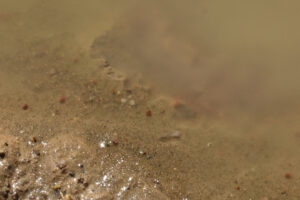
Ostracods at the edge of the water of Win Wan Corral Pond. The ostracods are red, egg-shaped bivalves barely 1 mm long. There is 1 at center, 2 to the left, and 1 at lower right.
Win Wan Corral Pond Ostracod Video 2023-10-12r
For a 1-minute, 28-seconds video of ostracods in Win Wan Corral Pond, click on the video player above. There is no audio. The ostracods are visible where they are swimming close to the water’s edge. Like fairy shrimp, they seem to swim in all different directions without clustering. Occasionally, some stop on the bottom as if scraping up a bit of food. They are all less than 1 mm long but some are tinier than the others. The smaller ones could be some other animal because their physiological features are not actually visible but their swimming behavior is similar to that of the larger ostracods.
October 24, 2023
The water level has dropped only a little. How long will the ostracods last?
- Down slightly from October 12 to about 15 m x 60 m; greater than 25 cm deep.
- Opaque pale brown water; 14 C at 1030.
- No fairy shrimp.
- Water boatmen (sub-order Heteroptera, family Corixidae), ostracods, ravens, cows.
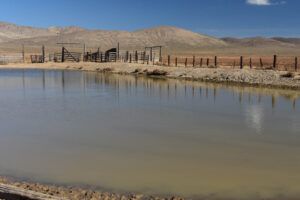
Win Wan Corral Pond in a view similar to Win Wan Corral Pond 2023-10-12, #08 (above). The water level is about the same. The wooden post at lower left can also be seen in photograph Win Wan Corral Pond 2023-08-24, #01 (above), where it is also just above the water’s edge.

Water boatman (sub-order Heteroptera, family Corixidae) in the net at Win Wan Corral Pond. I can’t catch ostracods because they are too small for the net.
Win Wan Corral Pond Ostracod Video 2023-10-24ab-cmr
For a 1-minute, 11-seconds video of ostracods in Win Wan Corral Pond, click on the video player above. There is no audio. The wind is stronger today so the ostracods are jostled about by the waves reaching the edge of the pond. They can be distinguished from small debris in the water because they commonly move obliquely to the wave currents. The video switches to a somewhat calmer location at 0:20. There are fewer ostracods but no debris and the swimming movements are obvious. Bright specks of light occasionally reflect off ostracod shells that are exposed above the water surface. Like the August 12 video, there are both larger and tiny animals swimming in similar ways. Maybe they are all ostracods, maybe not.
December 5, 2023
The pond is mostly frozen now. Ice I can reach from the shore is about 1 cm thick but there is some open water along the northern and western shores. It looks like the pond will last through the winter. That would impede a fairy shrimp hatch if the eggs need to dry out first.
- About 14 m x 55 m; depth greater than 10 cm.
- Clear water under the ice but murky pale brown around the edges; 4 C at 1230.
- No fairy shrimp.
- Ostracods.
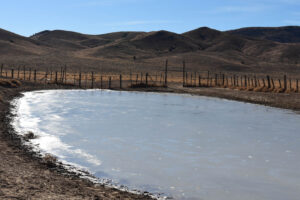
An ice-covered Win Wan Corral Pond. The pond is still big but it doesn’t extend under the fence at the south end.
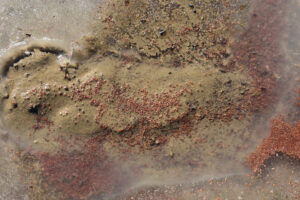
Tiny red ostracods amid the ice at the south end of Win Wan Corral Pond.
Win Wan Corral Pond Ostracod Video 2023-12-05ab-cr
For a 1-minute, 17-seconds video of ostracods in Win Wan Corral Pond, click on the video player above. There is no audio. There is a cluster of ostracods at the southern edge of the pond which was noticeable due to its red color. As I didn’t see clusters before, maybe this was triggered by the cold. Can ostracods huddle together for warmth? Some of those on the pond bottom are moving about but things don’t look good for those exposed on the mud and those floating against the ice. Maybe there are more ostracods in deeper water that are doing better. Could they survive the winter if the pond doesn’t freeze solid?
January 2, 2024
Just wanted to see if the pond survived the dry weather in November and December.
- 12 m x 40 m; water greater than 10 cm deep.
- Clear to opaque water; 100% covered by 2 cm ice at 1300.
- No fairy shrimp.
- Cows, couldn’t see any animals through the ice.
The pond survived without drying up at all in 2023; probably won’t be drying up any time soon.
March 8, 2024
Storms in early January, late January, early February, middle February, and early March have kept 2024 precipitation totals in Reno about 30% above normal. No doubt the pond has water but does it have fairy shrimp? In 2019, I saw small fairy shrimp on March 14.
- 17 m x 55 m; greater than 15 cm deep.
- Opaque water; 10 C at 1430.
- No fairy shrimp.
- Water boatmen 8-12 mm long (sub-order Heteroptera, family Corixidae), orange-red ostracods less than 1 mm long.
Win Wan Corral Pond Ostracod Video 2024-03-08-cr
For a 1-minute, 55-seconds video of ostracods in Win Wan Corral Pond, click on the video player above. There is no audio. It looks like the ostracods survived the winter after all, I just couldn’t see them through the ice on January 2nd. Either that or there has been a new hatch. The video opens with a photo that shows the pond has lots of water. As it is a calm day, the ostracods can venture into the clear water at the very edge of the pond without getting tossed around by the waves and are swimming back and forth, much like they were back in October 2023. A small, nearly black, shiny object appears on the surface of the water at upper left at 0:36-0:46 and looks like it is swimming. Another moves from left to right with the wind at 1:18-1:28. 2 more at the surface are blown to the right at 1:28-1:37. Could these also be ostracods?
March 27, 2024
Has the pond done whatever it needs to do to get the fairy shrimp to hatch? The 2 big ruts in the road west of Win Wan Flat have become more passable thanks to some vehicle traffic. At least a few vehicles have also driven through the chasm on the road from the east but that still requires above average clearance and 4WD.
- 15 m x 49 m; water depth greater than 15 cm.
- Opaque, pale greenish-brown water; 10 C at 1530.
- No fairy shrimp.
- Abundant water boatmen about 10 mm long (sub-order Heteroptera, family Corixidae), pair of small ducks standing on the shoreline, cows.
The ostracods are probably still here but are avoiding the edge of the water due to the wind and wave action. They are too small to catch in my net.
April 18, 2024
There have been a couple more warm spells and a little rain since the last visit and a cold spell and a little snow. Is that good enough for the fairy shrimp to hatch? The pond has shrunk only a little bit even though feral cows could be guzzling it down. A small group ran off at my approach. The pair of ducks is still here but now there are 4 more. The new ones are big enough to fly. Could they be the offspring? I never would have guessed this stinky stock pond would be an adequate home for a duck family. Their nearest neighbors could be 15 km or more away (e.g., Wrecked Windmill Pond in Soda Spring Valley) As on the last visit, the ducks were at the south end of the pond. They took flight about the time I got to the edge of the water. They flew over me for a look, circled around a couple of times, obviously didn’t see another pond to land in, came back, and landed at the south end. They stayed at the south end of the pond while I walked around sweeping my net through the water. A bird that looks kind of like a willet is hanging out with them. I avoided the southern half of the pond and hope that didn’t bias the results of my search. Meanwhile, a half dozen or so small, sandpiper-like birds flew in and started feeding, or trying to feed, along the shore. They ignored me and spent most of their time standing with their heads in the water. Where the heck did they come from? Did they find anything to eat? As I was wrapping up my search, I was startled by a loud huff. I looked up to see a dark stallion eyeing me intently from about 50 m away. It pranced back and forth a bit while I loaded up my pack and got back on my mountain bike. I came for the fairy shrimp and got a lesson in high-desert ecology.
- 14 m x 46 m; water depth greater than 10 cm.
- Opaque, pale greenish-brown water; 13 C at 1100.
- No fairy shrimp.
- Abundant water boatmen of various sizes (sub-order Heteroptera, family Corixidae), black diving beetles, ostracods (saw only 1 but others are presumably hiding out in deeper water), very small coiled red larvae, ducks, semi-palmated sandpipers(?), willet(?), cows, horse.
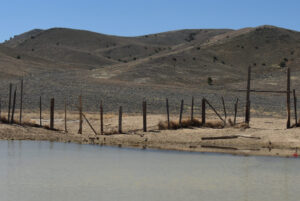
Ducks and willet(?) at south end of Win Wan Corral Pond. If the ducks include the pair I saw back on March 27, then the others might be their offspring. There appear to be 6 ducks: 1 in front of the gate, 1 at center, and 4 or 5 clustered at dry outlet to left of center. The willet(?) is in the water to the left of the clustered ducks.

Small sandpipers with their heads in the water along the shore of Win Wan Corral Pond. They might be eating some of the abundant water boatmen. Their pale, non-striped bellies suggest these are semi-palmated sandpipers rather than least sandpipers. However, the Audubon Guide to North American Birds says least sandpipers would be more likely because they migrate west of the Rockies from the West Coast on their way north while semi-palmated sandpipers migrate east of the Rockies from the Gulf Coast.
May 2, 2024
Thunderstorms in western Nevada on April 24-26 might have added some water to the pond. Warm temperatures definitely would have taken some water out. Did the pond last 2 weeks?
- 13 m x 43 m; greater than 5 cm deep.
- Opaque, pale brownish-green water; 12 C at 1300.
- No fairy shrimp.
- Dark and pale water boatmen less than 10 mm long (sub-order Heteroptera, family Corixidae), phalaropes, cows, horses.
The greener water indicates the algae is doing well with plenty of nitrates from the cows and horses. The ducks have moved on but a group of 6 phalaropes is visiting. They didn’t bother to fly off while I walked the shoreline with my net. Maybe they are occasionally catching a water boatman. If the ostracods are still here, they aren’t venturing to the very edge of the water where I would be able to see them.
June 11, 2024
May was dry but there were thunderstorms earlier in June. They evidently missed Win Wan Flat.
- Dry.

Remains of a water boatman on the dried mud of Win Wan Corral Pond. The exoskeleton certainly looks like a water boatman but I can’t be sure. They were here on May 2 and it looks like they lasted until the last drop of water. In places, I can see 3 carcasses within a circle of radius 10 cm so there were quite a few of them. Water boatmen have wings and can fly but the nearest water is “Walker Lake”, 30 km away.
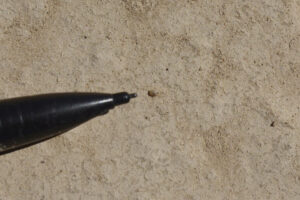
Ostracod shell on the dried mud of Win Wan Corral Pond. Ostracod shells don’t decay easily and can become fossils. However, the position of the shell on the surface of the mud like this does suggest the ostracod died when the pond dried up recently. I saw 1 live ostracod on April 18 but none on May 2.
February 27, 2025
I’m hoping the rains in early and mid-February were enough to get this pond started.
- Dry.
September 4, 2025
After the thunderstorms on August 23-27, Garfield 5890 Saddle Pond still has a tiny bit of water and fairy shrimp. I may be too late here but it’s worth a look.
- Dry, not even damp. The thunderstorms must have missed this pond.
Win Wan Flat West Pond (Stillwater BLM Office)
Win Wan Flat West Pond is at the west end of the brush-free playa on Win Wan Flat. As explained for Win Wan Corral Pond, neither the 1:100,000-scale BLM map nor the Win Wan Flat 7.5-minute topographic quadrangle show playa symbols. The Win Wan Flat quadrangle has 2 small, dashed blue circles on Win Wan Flat. The western one likely represents Win Wan Flat West Pond. The pond is approximately circular and surrounded by a low mound of dirt, except on the north side. A small linear ditch leads into the pond from the northern part of the playa and is presumably intended to collect water for the pond. However, there does not seem to be enough of a gradient for water in the ditch to flow much, if at all. When the pond had water on March 19, 2022, the ditch had ponded water for a distance of 150 m or so from the pond. The pond is about 60 m from the road through Win Wan Flat. It is visible from the road when it has water but is otherwise inconspicuous.
For access, see Win Wan Corral Pond.
Elevation: 1,881 m (6,170′)
March 17, 2022
After seeing this pond on an online version of the Win Wan Flat 7.5-minute topographic quadrangle, going back to look for it was high on my list. I hadn’t noticed it on my previous visits to Win Wan Corral Pond. Due to the snowy December, I expected it to get some water this winter but I waited until March because of the elevation and likely cool temperatures. As it turned out, I couldn’t miss the pond as the ditch to the pond had water across the Win Wan Flat road. The road also had several puddles and even a few patches of icy snow where the southern bank of the road offers shade. 80-90% of the pond and the ditch are covered by 1-3 mm of ice even at noon but it is melting near the shore.
- 20 m x 21 m; measured 6 cm depth near shore but this is meaningless as I measured 15 cm in the ditch on March 24.
- Opaque pale brown water; 5 C at 1230 on a cloudy day.
- Small fairy shrimp, maybe 4-7 mm long; fairly abundant so I was able to net a few in the narrow ice-free zone near the shore.
- Didn’t see other animals.
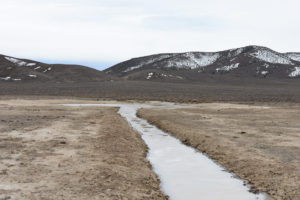
Looking south down the drainage ditch into Win Wan Flat West Pond. Both the pond and the ditch are mostly covered with ice.

2 small fairy shrimp in the bottom of the net at Win Wan Flat West Pond. The eye and part of the head of the fairy shrimp at left are sticking above the water surface.
March 24, 2022
No puddles on the road and no water in the ditch north of the road. There are still a few patches of snow in shady spots on the north slopes of the hills. There is about a meter of damp mud around the edge of the pond. 2 cows ran off on my approach but the pond isn’t severely pockmarked yet.
- 18 m x 21 m; measured 15 cm depth in the ditch about 10 m north of the pond.
- Opaque pale brown water; 16 C in 3 cm water at 1115 in the sun.
- Fairy shrimp 8-12 mm long, a few have a bluish-gray color; lots have eggs.
- Killdeer.
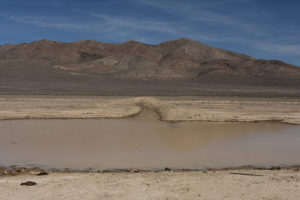
Win Wan Flat West Pond, looking north down the ditch with Chukar Ridge of the Gabbs Valley Range in the distance. Today is very warm with no sign of ice near mid-day. Cows have been here but the pond hasn’t been heavily trampled yet.
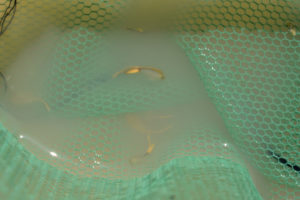
Fairy shrimp in the net at Win Wan Flat West Pond. The female at center is of the oldest and largest generation and has a large egg-filled ovisac. Females at top and bottom are smaller and have smaller egg-filled ovisacs but it is hard to distinguish clusters of lengths that would represent distinct generations. It may be that the pond population is the result of continuous hatching over a few days.
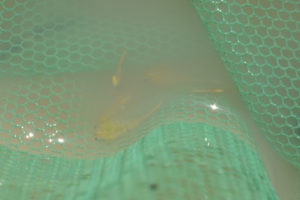
Male fairy shrimp and others in the net at Win Wan Flat West Pond. The antennae II of the male below center are poorly visible but the distal segments look more blade-like than tubular. Their ends touch but do not cross over the middle of the body about 2/3 of the way down the thorax. This is similar to Branchinecta coloradensis tentatively identified in Smith Creek Road Long Ditch Pond, BTANSD (March 17, 2013 on the Smith Creek Valley page), and photograph Bald Mountain “Dry” VABM Saddle Pond 2019-05-02 #20c (Pine Grove Hills). The male’s tiny third eye, or ocellus, can also be seen in this photograph.
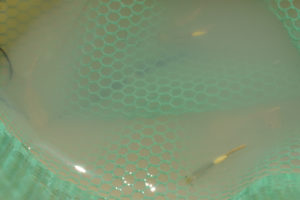
One of the uncommon bluish-gray fairy shrimp in the net at Win Wan Flat West Pond. The female at lower right has a distinctly different color – compare to photograph Win Wan Flat West Pond 2022-03-24, #08, above. Garfield 5890 Saddle Pond also had a few bluish fairy shrimp on March 14, 2022, such as the one at the lower right edge of Garfield 5890 Pond Fairy Shrimp Video 2022-03-14cm-r at 1:25-1:30 (see March 14, 2022 for Garfield 5890 Saddle Pond on the Garfield Hills page). Although the different color might suggest a different species, the eggs and ovisacs look the same as on the pale gray fairy shrimp. Fairy shrimp colors can vary within the same species and are rarely reported in the scientific literature. Why would colors vary within the same pond?
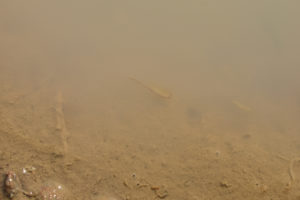
Fairy shrimp swimming at edge of Win Wan Flat West Pond. If you come upon a pond with opaque water and you don’t have a net, don’t despair. With luck, there may be a few fairy shrimp swimming in water so shallow at the edge of the pond that they are visible. Patience sometimes pays.
August 24, 2023
The abundance of water in Win Wan Corral Pond in March 2019 but not in March 2022 when Win Wan Flat West Pond had water suggested that ditch work between March 2019 and March 2022 had rerouted some drainage into Win Wan Flat West Pond at the expense of Win Wan Corral Pond. This summer’s thunderstorms apparently changed all that. Win Wan Corral Pond has abundant water today but this one doesn’t. The ditch across the road is now just a small dip. Mud flakes and deep hoof prints indicate Win Wan Flat West Pond did get some water from the August thunderstorms but it has all evaporated.
- Dry.
March 8, 2024
There’s lots of water in Win Wan Corral Pond but this one evidently isn’t receiving much overland flow anymore.
- Dry.
Winter 2022 Fairy Shrimp Hatching History in the Garfield and Candelaria Hills and the Gabbs Valley Range
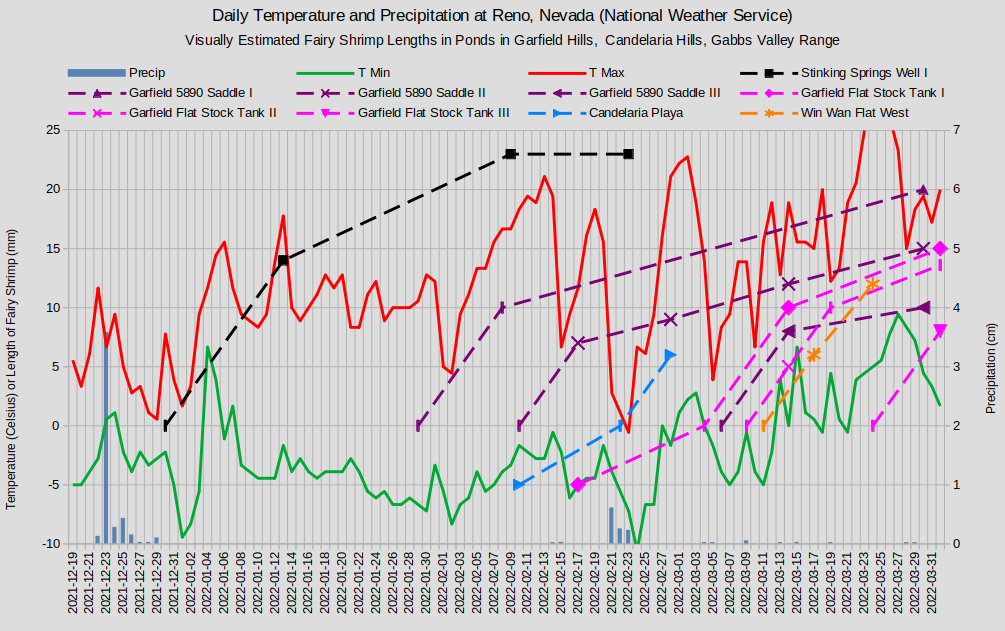
Fairy shrimp lengths are indicated by the dashed lines where 0 lengths are on the inferred days of hatching. The vertical dash symbol indicates a calculated length. From hatching to 10 mm length, the growth rate is assumed to be 1 mm/day. For post-10 mm growth rates, see text below. -5 fairy shrimp lengths mark dates when fairy shrimp were not observed. Garfield 5890 Saddle Pond generation IV is not shown because it would obscure Garfield Flat Stock Tank Pond generation III. Growth of the first generation in Stinking Springs Well Pond is shown for comparison.
Only 1 generation of fairy shrimp was observed in Win Wan Flat West Pond. Lengths were about 6 mm on March 17 and 12 mm on March 24. Between those 2 dates, the average rate of growth was 0.86 mm/day. The graph shows hatching on March 11 and a growth rate of 1 mm/day to the first observation on March 17. If the fairy shrimp had actually grown at an average rate of 0.86 mm/day during that interval, they would have hatched a day earlier on March 10.
For further discussion, see “Winter 2022 Fairy Shrimp Hatching History in the Garfield and Candelaria Hills and the Gabbs Valley Range” on the Garfield Hills page.
What Can We Learn from the Ponds in the Gabbs Valley Range?
Win Wan Flat has 2 ponds and both have had fairy shrimp at various times. Win Wan Corral Pond had fairy shrimp in 2019 but not in 2022. Win Wan Flat West Pond had fairy shrimp in 2022 and much more water than Win Wan Corral Pond. Dirt work between fairy shrimp occurrences in 2019 and 2022 may have changed drainage on the playa to the extent that Win Wan Corral Pond was no longer viable habitat. The summer 2023 thunderstorms changed that as Win Wan Corral Pond had abundant water in late August but Win Wan Flat West Pond was dry. Win Wan Corral Pond remained wet and Win Wan Flat West Pond remained dry through April 2024.
Win Wan Corral Pond and Win Wan Flat West Pond are heavily used by horses and cows.
There are at least 2 species of fairy shrimp in Win Wan Corral Pond. Large individuals of the species Thamnocephalus platyurus were identified in late August 2023 by their flap-like uropods although frontal appendages were not seen. They coexisted with a different species of smaller fairy shrimp which lacked distinctive macroscopic features. T. platyurus was not observed among March or April hatches of other years.
Win Wan Corral Pond remained wet from August 2023 through April 2024. No fairy shrimp hatched in 2024. The populations of the 2 species may require desiccation for their eggs to hatch. Alternatively, the appearance of T. platyurus may have been a failed colonization attempt and the other species failed to hatch due to a lack of the necessary environmental triggers.
Ostracods were observed in October and early December of the wet 2023 and again in March and April of 2024.
The wood in the corral is strongly weathered so Win Wan Corral Pond has probably been there for a long time. Also, the Win Wan Flat 7.5-minute topographic quadrangle, which shows the ponds, was based on aerial photographs taken in 1974. Colonization has consequently had 50 years or more to achieve success.
It would seem rather easy for fairy shrimp eggs at Win Wan Flat to have been blown in from Soda Spring Valley, which has fairy shrimp and is only 12 km (7 miles) to the south. However, a surprising number of water birds were seen at Win Wan Corral Pond in 2024, including ducks, sandpipers, willetts, and phalaropes.